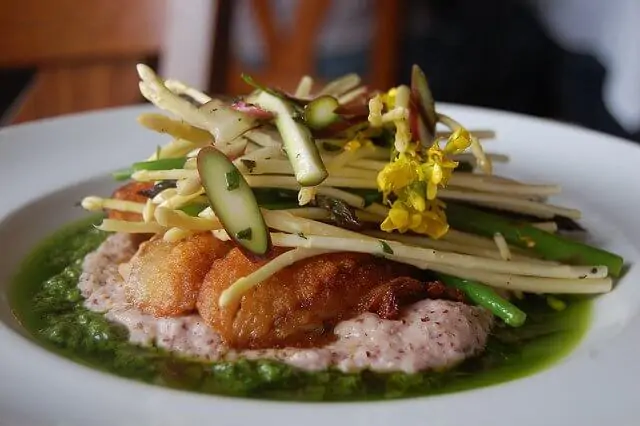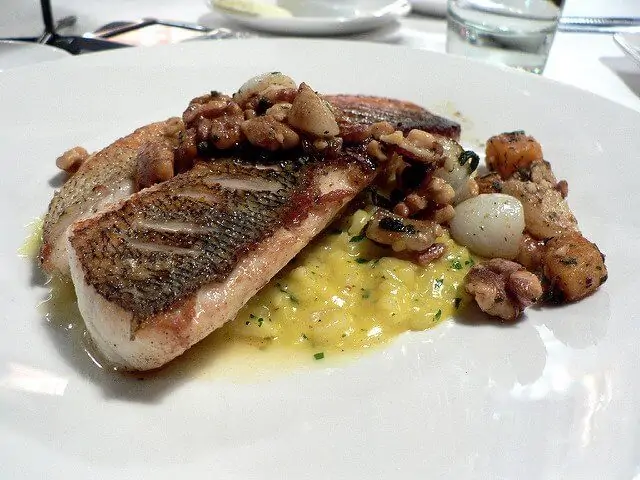
When you ask fish lovers for their favorite fish, walleye and halibut are often at the top of the list. Walleye are found in the northwestern states and are a mildly-sweet white fish.
Do you catch your own fish? If so, check out this article to learn about electric knives for cleaning fish. You might also be interested in the best electric knife sharpener for fillet knives.
It’s hard to ruin this fish so, if you haven’t pan-fried walleye yet, it’s time to try!
Which pan should I use?
A good pan-fried meal begins with a good pan! Of course, there are no hard rules on which type is best. You might want to try cooking your fillets in a cast-iron skillet, which has a lot of great benefits. Some might favor a stainless steel pan with a core. You could also use non-stick, Teflon-free ceramic cookware.
Regardless of what pan you use, make sure it’s large enough so that the fillets will fit comfortably into the pan. You don’t want them overlapping or curling around the edges. The fillets should lie flat and straight.
Choose your oil.
You have numerous options when it comes to the fat you can use to pan-fry fish. Olive oil will impart some flavor to walleye. If you’re a fan of olive oil, that subtle flavor may be a welcome addition.
Check out Kirkland Signature Extra Virgin Olive Oil at Amazon
Canola oil is also a good oil for mild, white fish like walleye. Canola has an excellent balance of fatty acids. It’s low in saturated fats, high in monounsaturated fats, and has some polyunsaturated fats, such as Omega-6 and Omega-3.
Check out La Tourangelle Organic Canola Oil at Amazon
Whichever oil you use, use it sparingly.
Seasoning your fish.
Seasoning is another very personal choice. With a mild and sweet fish, unless you’re specifically looking for a spicy taste, you can’t go wrong with salt, lemon pepper, and a dash of dill seed. Mix your seasoning with the flour you’ll use to dust your fish.
Getting started.

If the fillets are not already skinless, you may prefer to remove the skin, which can alter the taste of this sweet fish. Use your favorite, quality chef’s knife to cut the skin from the flesh. Do this by placing the fish on a composite cutting board, skin-side-down, and cut with a slow back-and-forth motion.
You need two bowls, one with your flour and seasoning mix, and another bowl with a mixture of beaten egg, a little milk, and a little water. This egg dip should be thin but still “eggy.”
Cut a lemon into thin rounds, then slice into the lemon slices about halfway on one side so that you can twist them to make a curl for the garnish.
Heat the pan over medium heat and, when the pan is hot, add the oil. There should be enough oil to coat the pan, but the fish shouldn’t be swimming in it. The oil should be shimmery before you add the fish fillets.
Check out the best cast iron skillet for steak.
Add the seasoning and breading.
Dry the fillets with a paper towel, then lightly dust with the flour and seasoning mixture. Dusting is different from dredging. Your goal is to provide a very light coat of flour both to slightly dry the outside of the fish and to give the dip something to hold onto.
Dip the fillets in the egg dip and hold them over the bowl for a second or two to drain the excess. Place the fillets back into the flour mixture for another light dusting.
Check out Shiakiku Panko Bread Crumbs at Amazon
NOTE: You can skip the flour dusting and egg dip and simply place the “naked” fillets in the oil for a slightly different taste, without the crunch of breading. In this case, season both sides of the fish before placing it in the pan. You can use panko bread crumbs, pecan flour, or finely ground cornmeal for the second dusting.
Frying your walleye fillets.
Place the fillets into the hot pan, and gently move them slightly or slide your spatula under them to ensure they aren’t sticking. Dribble some oil on the upper side of the fish facing you in the pan. When you turn the fish over, the oil will provide an additional oil base for the second side.
NOTE: If you’ve decided to cook the fillets with the skin on, fry the “presentation” (non-skin) side first.
Let the fish fry for about three to five minutes on each side, depending on thickness. Do not make them anxious by moving them around or lifting them. If you suspect they are overcooking or the pan is too hot, gently lift an edge to peer beneath. You’re looking for a good sear. Don’t let them get black. You can’t get away with telling your guests that’s “blackened” walleye!
The internal temperature of cooked fish is 145o F. If you don’t have a meat thermometer (see reviews of good meat thermometers), the cooked fish should be opaque and flake easily. The temperature of stoves differs, so experimentation will let you determine the ideal temperature setting and time for your stove and pan. Fish overcooks easily.
Garnish and serve!
Transfer the fillets to a paper towel for a few seconds to let them drain. Plate your fillets, add a lemon garnish to the top, and serve. If you like, mix a little honey and lemon juice and drizzle it lightly over the top for extra flavor.
The sides are up to you, of course, but some suggestions are coleslaw and oven potato fries.
Image credit via Flickr Creative Commons: Stuart S.









i like to drizzle the fish fillets with lemon juice, and serve with cottage cheese and a salad.
That sounds great! Thanks for your comment Arthur!